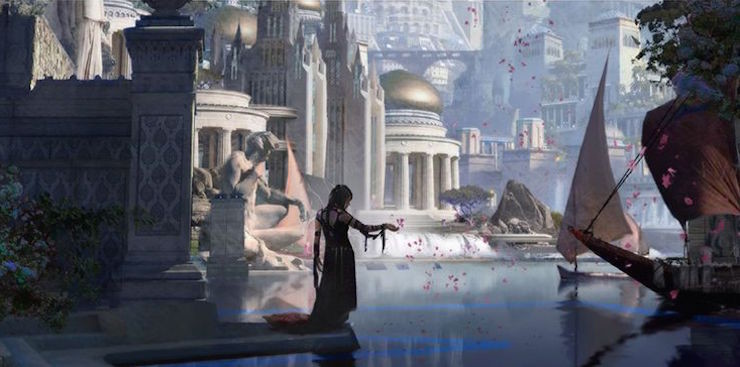In the land of Eivar, music and magic were once woven together inextricably. But when a small contingent of the Seers—poets who performed enchantments through song—turned to forbidden blood-magic, Davyd the Dreamweaver was forced to strip all Seers and poets of their magic: “A word was a word, no more.” Yet generations later, poems and their words retain nearly the same power as spells: Empires are built and undermined by poets who often wield more influence than even their royal sponsors. Ilana C. Myer’s debut novel Last Song Before Night tracks a group of young poets and their muses (their loves and enemies) as they unwittingly play into a prophecy to bring the magic back to Eivar.
The very words that Last Song Before Night venerates, protects, and unearths in turn shape the structure of the book itself. The narrative arcs and the characters adopt the style of the words they describe—that is, the epic poetry written and performed by both aspiring poets and disgraced Seers. Last Song Before Night reads less like a novel and more like the kind of song poets would sing, strumming their harps with fingers bedecked with Academy rings, about how the youngest generation of poets overturned the city of Tamryllin’s history of poetry and privilege.
Like any good epic, the story covers a lot of ground, spanning from the seaside city of Tamryllin to the Blood Sea to a wintry forest standing in as a group vision, and is peppered with an almost overwhelming number of characters:
- The golden-boy poet and his other half, equally talented but dogged by shadows.
- The sheltered, naive, virginal maiden trapped in an arranged marriage to a nebbish childhood friend who doesn’t know the right end of a sword.
- The plucky young woman disguising herself as a boy in order to infiltrate the poets’ old boys club and in turn discovering her own destiny.
- Her sadistic brother, a hunter following her trail.
- The hooker with a heart of gold.
- The wise mentor-slash-fugitive who frustratingly pops in and out of the plot.
- The evil, two-faced villain masquerading as the realm’s hero.
The main players of Last Song Before Night are more archetypes than characters—but it completely works. With their many narrative threads getting tangled into snarled knots, economy of story is key: Myer uses existing fictional constructs to evoke the context to the reader without having to go into unnecessary detail about each individual. One necessary detail, however, are their names: Characters are almost always referred to by their full names, attaining almost mythical status for how often the text refers to them as Darien Aldemoor, Marlen Humbreleigh, Kimbralin Amaristoth, Valanir Ocune, Edrien Lettrell, and so forth.
These archetypes represent something larger than themselves—not unlike the Doctor in Doctor Who, self-selecting a title as his alias but also as a promise to emulate doctors’ lack of cruelty and cowardice, and their vow to never give up on their patients. It’s a useful shorthand that also helps the reader guess at where each person will end up: Of course the virginal maiden will spend some time in the school of hard knocks and explore her own sexuality; we need to see if the dark poet can overcome his emotional and physical scars to reach the light; and the Chosen One must herself make an impossible choice.
In plotting, as with characterization, Myer favors macro over micro, giving us a sweeping plot over a more specific one. As in epic poetry, there are plenty of scenery changes, world-ending stakes, and transformations that see the aforementioned archetypes either evolving into their final forms or becoming an entirely different archetype. Sheltered Rianna Gelvan spends a month out in the real world, which sees her losing her treasured golden hair and her virginity—and putting her knife lessons to good use. Nebbish Ned goes from bitterly rejected by Rianna to fighting pirates in the Blood Sea, for crissakes! Oh, and let’s not forget Lin, who has a Hero’s Journey to challenge Luke Skywalker’s: She disguises herself as a boy, has her true identity revealed, gets possessed somewhere along the way… And I haven’t even spoiled any big moments for you guys. It’s impressive when you consider that no more than a year could have passed from start to finish of the tale. It’s kind of like Rent in that respect—these symbolic characters going through the “Seasons of Love” and emerging transformed.
Even though the last third of the book is concerned with returning magic to Eivar, in her writing Myer demonstrates the everyday magic of words not imbued with enchantments: She takes story tropes, building blocks that have been used in so many constructions that their specific features have been worn away, and reminds us what we appreciate about those familiar characters. The classic redemption story and what it earns you, the gender politics of disguising yourself as another sex, the lost magic lingering at the edges of the story waiting to be recovered.
Last Song Before Night is now available from Tor Books. Read an excerpt on Tor.com.
Natalie Zutter has been listening to the Hamilton cast recording all week and believes it is nothing short of magical. You can read more of her work on Twitter and elsewhere.










